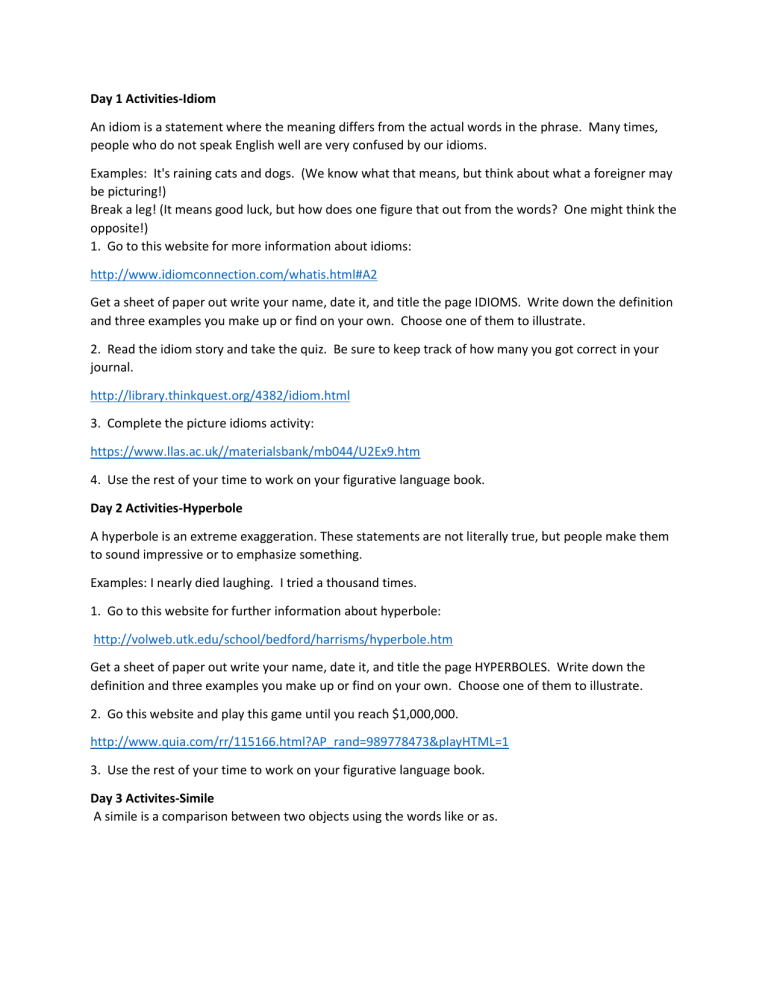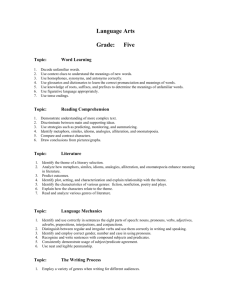
Day 1 Activities-Idiom An idiom is a statement where the meaning differs from the actual words in the phrase. Many times, people who do not speak English well are very confused by our idioms. Examples: It's raining cats and dogs. (We know what that means, but think about what a foreigner may be picturing!) Break a leg! (It means good luck, but how does one figure that out from the words? One might think the opposite!) 1. Go to this website for more information about idioms: http://www.idiomconnection.com/whatis.html#A2 Get a sheet of paper out write your name, date it, and title the page IDIOMS. Write down the definition and three examples you make up or find on your own. Choose one of them to illustrate. 2. Read the idiom story and take the quiz. Be sure to keep track of how many you got correct in your journal. http://library.thinkquest.org/4382/idiom.html 3. Complete the picture idioms activity: https://www.llas.ac.uk//materialsbank/mb044/U2Ex9.htm 4. Use the rest of your time to work on your figurative language book. Day 2 Activities-Hyperbole A hyperbole is an extreme exaggeration. These statements are not literally true, but people make them to sound impressive or to emphasize something. Examples: I nearly died laughing. I tried a thousand times. 1. Go to this website for further information about hyperbole: http://volweb.utk.edu/school/bedford/harrisms/hyperbole.htm Get a sheet of paper out write your name, date it, and title the page HYPERBOLES. Write down the definition and three examples you make up or find on your own. Choose one of them to illustrate. 2. Go this website and play this game until you reach $1,000,000. http://www.quia.com/rr/115166.html?AP_rand=989778473&playHTML=1 3. Use the rest of your time to work on your figurative language book. Day 3 Activites-Simile A simile is a comparison between two objects using the words like or as. Examples: Her hair was like woven silk after she got out of the shower. He was as cool as a cucumber sitting in front of the air conditioner on the hot summer day. 1. Go to this website for further information about similes: http://www.englishclub.com/vocabulary/figures-similes-list.htm Get a sheet of paper out write your name, find the section for figurative language, date it, and title the page SIMILES. Write down the definition and three examples you make up or find on your own. Choose one of them to illustrate. 2. Complete this quiz: http://www.softschools.com/quizzes/grammar/similes/quiz3468.html 3. Check out some of these poems written by children. Choose one or two to copy into your journal (include author). Use a highlighter to identify the similes within the poem. Underline the two nouns that are being compared and circle the like or as. http://library.thinkquest.org/J0112392/simile.html 4. Use the rest of your time to work on your figurative language book. Day 4-Metaphor If you can create a simile, you can easily make it into a metaphor by removing the like or as. A metaphor is a comparison between two objects not using like or as. Example: The bully was a tank plowing through the crowd. The popcorn was a fireworks display as it popped in the microwave. 1. Go to this website for further information about metaphors: http://www.englishclub.com/vocabulary/figures-metaphor.htm 2. Open your figurative language journal, date it, and title the page METAPHOR. Write down the definition and three examples you make up or find on your own. Choose one of them to illustrate. 3. Check out some of these poems written by children. Choose one or two to copy into your journal (include author). Use a highlighter to identify the metaphors within the poem. Underline the two nouns that are being compared. http://library.thinkquest.org/J0112392/metaphor.html 4. When you finish, use your time to complete other days of the webquest you didn't finish, or work on your figurative language book. Day 5-Onomatopoeia 1. Go to this website to learn more about onomatopoeia. http://www.tnellen.com/cybereng/lit_terms/onomatopoeia.html 2. Get a sheet of paper out write your name, date it, and title the page ONOMATOPOEIA. Write down the definition and three examples you make up or find on your own. Choose one of them to illustrate. 3. Onomatopoeia scavenger hunt: Look at this activity sheet: http://www.readwritethink.org/files/resources/lesson_images/lesson909/OnomatopoeiaWorksheet.pd f Copy the chart in your journal. Do not copy the example. Then go to http://www.poemhunter.com and find five examples of onomatopoeia in poems of your choosing. Record them on a chart. 4. Comic strip: Get a white sheet of paper and fold it into four sections. Create a comic strip using at least five onomatopoeia words. Day 6-Alliteration Alliteration is the repetition of initial sounds in neighboring words in order to increase memory. Several tongue twisters use alliteration. Example: Peter Piper picked a peck of pickled peppers. She sells sea shells by the sea shore! 1. Use the Google app on your ipad to find out more information about alliteration. 2. Get a sheet of paper out write your name, date it, and title the page ALLITERATION. Write down the definition and three examples you make up or find on your own. Choose one of them to illustrate. Day 7-Personification 1. Go to this website to find out what personfication is: http://www.buzzle.com/articles/examples-of-personification.html 2. Get a sheet of paper out write your name, date it, and title the page PERSONIFICATION. Write down the definition and three examples you make up or find on your own. Choose one of them to illustrate.




